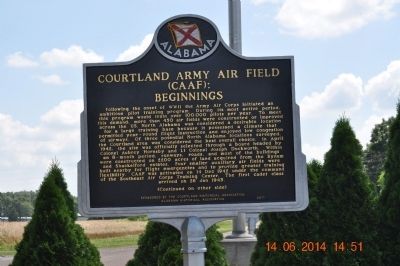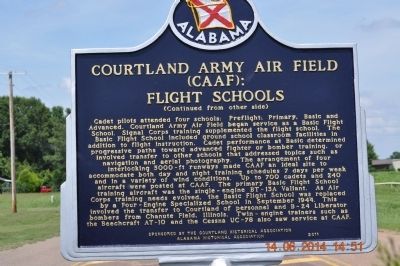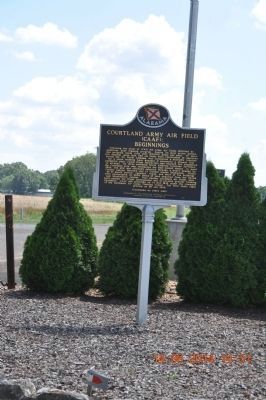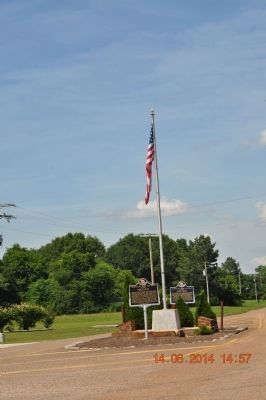Courtland in Lawrence County, Alabama — The American South (East South Central)
Courtland Army Air Field (CAAF): Beginnings/Flight Schools
Courtland Army Air Field (CAAF): Beginnings
Following the onset of WWII the Army Air Corps initiated an ambitious pilot training program. During its most active period, this program would train over 100,000 pilots per year. To meet this demand, more than 450 air fields were constructed or improved across the US. North Alabama was considered a desirable location for a large training base because it possessed a climate that permitted year-round flight instruction and enjoyed low congestion of airways. Of three potential North Alabama locations surveyed, the Courtland area was considered the best overall choice. In April 1942, the site was officially selected through a board headed by Colonel Aubrey Hornsby and Lt Colonel Joseph Duckworth. Within an 8-month period, runways, roads, and most of the buildings were constructed on 2200 acres of land acquired from the Bynum and Shackelford estates. Four smaller auxiliary air fields were built nearby for flight emergencies and to provide greater training flexibility. CAAF was activated on 14 Dec 1942 under the command of the Southeast Air Corps Training Center. The first cadet class arrived on 26 Jan 1943.
Courtland Army Air Field (CAAF): Flight Schools
Erected 2011 by Courtland Historical Association, Alabama Historical Association.
Topics and series. This historical marker is listed in these topic lists: Air & Space • War, World II. In addition, it is included in the Alabama Historical Association series list. A significant historical month for this entry is April 1942.
Location. 34° 40.104′ N, 87° 20.121′ W. Marker is in Courtland, Alabama, in Lawrence County. Marker is at the intersection of Sanderson Lane and WC Handy Avenue, in the median on Sanderson Lane. Touch for map. Marker is in this post office area: Courtland AL 35618, United States of America. Touch for directions.
Other nearby markers. At least 8 other markers are within 2 miles of this marker, measured as the crow flies. Courtland Army Air Field (CAAF): Facilities/Deactivation (a few steps from this marker); Harris-Simpson Home (approx. 1.3 miles away); A Cotton Kingdom (approx. 1.4 miles away); The African ~ American Experience (approx. 1.4 miles away); The Town of Courtland / Early Settlers (approx. 1.4 miles away); The Red Rovers / Red Rovers Roster (approx. 1.4 miles away); American Legion - Post 58 (approx. 1.4 miles away); Courtland's Early Architecture (approx. 1.4 miles away). Touch for a list and map of all markers in Courtland.
Also see . . .
1. Vultee BT-13 Valiant. The Vultee BT-13 Valiant was an American World War II-era basic trainer aircraft built by Vultee Aircraft for the United States Army Air Corps, and later US Army Air Forces. A subsequent variant of the BT-13 in USAAC/USAAF service was known as the BT-15 Valiant, while an identical version for the US Navy was known as the SNV and was used to train naval aviators for the US Navy and its sister services, the US Marine Corps and US Coast Guard. (Submitted on June 16, 2014, by Sandra Hughes Tidwell of Killen, Alabama, USA.)
2. Beechcraft AT-10 Wichita. The Beechcraft AT-10 Wichita was a World War II trainer built for the United States Army Air Forces (USAAF) by Beechcraft and the Globe Aircraft Company. It was used to train pilots for multi-engined aircraft such as bombers. (Submitted on June 16, 2014, by Sandra Hughes Tidwell of Killen, Alabama, USA.)
3. Cessna AT-17 Bobcat. The Cessna AT-17 Bobcat was a twin-engined advanced trainer aircraft designed and made in the United States, and used during World War II to bridge the gap between single-engined trainers and twin-engined combat aircraft. The AT-17 was powered by two Jacobs R-755-9 radial piston engines. The commercial version was the Model T-50, from which the AT-17 was developed. (Submitted on June 16, 2014, by Sandra Hughes Tidwell of Killen, Alabama, USA.)
4. Joseph Duckworth. Joseph B. Duckworth (September 8, 1902 – July 26, 1964) was a colonel in the United States Air Force, and was regarded as the "father" of modern instrument flight. He is also noted in record books as being the first person to fly through the eye of a hurricane. (Submitted on June 16, 2014, by Sandra Hughes Tidwell of Killen, Alabama, USA.)
5. Aubrey Hornsby. Aubrey Thomas Hornsby I (January 8, 1895 – May 23, 1981) was a U.S. Army officer and pioneer aviator who reached the rank of Brigadier General. He began his Army career during World War I as an artillery observer, seeing service in France and Germany, then continued to serve as an aviator and administrator through World War II, after which he was elected to the Alabama House of Representatives. (Submitted on June 16, 2014, by Sandra Hughes Tidwell of Killen, Alabama, USA.)
Credits. This page was last revised on June 16, 2016. It was originally submitted on June 14, 2014, by Sandra Hughes Tidwell of Killen, Alabama, USA. This page has been viewed 1,403 times since then and 95 times this year. Photos: 1, 2, 3, 4. submitted on June 14, 2014, by Sandra Hughes Tidwell of Killen, Alabama, USA. • Bernard Fisher was the editor who published this page.



